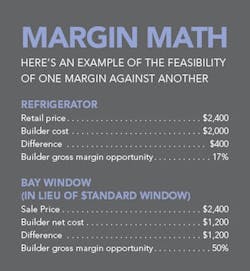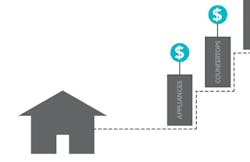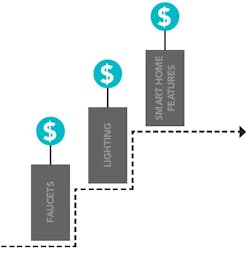Home Builders, Sharpen Your Options Strategy
Two basic strategies exist for adding features to homes: You can include all the options in the base house, or you can minimize features in the base house and offer upgrade options.
I know builders who sell a lot of options and make very little money. So, rather than just focusing on selling as many options as possible, let’s focus on what to consider when setting an option margin to make as much money as possible on a given house. In some cases, that may mean selling fewer options in order to prevent discounting a home at closing due to an appraisal or financing issue.
Volume usually translates to economies of scale, so including options in the base house allows the builder to get lower costs on materials and appliances. Here, the feature in question—such as quartz countertops—is standard in every home built. To decide if this approach is right for you, you’ll need to compare the cost of the included feature against both a prospective homeowner’s perceived value and the appraiser’s dollar value. You can find out dollar value by contacting a local appraiser. It will probably involve paying a fee, but the information is invaluable. Features that are valued higher than the builder’s cost (plus margin) are likely candidates for inclusion. This kind of comparison needs to be ongoing so that you’re always sure the features you’re offering are ones that buyers really want. Market research is essential.
Many builders are successful because they keep the base house specs low and allow buyers to personalize the home through upgrade options. This can be done through a sales office, design studio, or third-party showroom.
The upgrade-option approach is back in style: Buyers want the ability to personalize their new home. The disadvantages for the builder include increased complexity, lower productivity, and higher costs. The advantages are: flexibility for the buyer, a lower starting price, and better margins on the upgrade option. If done well, options are also a leg up on the competition. Here’s advice on how to offer options efficiently.
Price Options Competitively
Homebuyers are better informed than ever before. They’re able to comparison-shop many options online—including on their smartphones while standing in a builder’s design studio. If too high a margin is placed on a shoppable item (such as a washer, dryer, or window blinds), then the buyer could question the value of the house they are buying. On the other hand, if the upgrade item is competitively priced, it can make the buyer feel more confident in their selection of builder.
Margin Should Reflect Complexity and Risk
All options are not created equal. Structural options are much more disruptive, involve more trades, and carry more risk than, say, appliances. They also require more back-office setup. Obviously, the margin on a 2-foot wall extension or a bay window option should be better than, say, a refrigerator upgrade.
Purchasing systems need to reflect the deletion and addition of base house and option material quantities and labor bids. For example, offering a bow wall option with a fireplace option involves additional floor covering for the bump-out (which is then deducted for the fireplace hearth).
When Setting Option Proces, Consider Base House Cost
Some options are more apt to be chosen by a buyer than others due to the cost of base house materials. For example, if a buyer were to wait to upgrade their carpet post-close, they would essentially be paying for builder-grade carpet, the labor to install it, the labor to have it ripped out, and the installation cost of the new carpet. Options that have base house cost offsets should have better margins than those that do not.
When Possible, Bundle
Packaging options helps to streamline the buying experience. Charles Roberts, vice president of operations at Providence Homes, in Jacksonville, Fla., uses an interior designer who meets with each homebuyer, helps sort out options, and offers advice on colors, cabinets, and flooring choices. Providence Homes also recently packaged bathroom faucets and accessories together to simplify the process for buyers. Since Providence began bundling, Roberts reports a significant uptick in bath upgrades. Well-trained staff assisting with selections can minimize buyer remorse about selections that may be less-than-optimal combinations.
Price Upgrades Simply and Logically
Whether bundling options into a package or selling them à la carte, it’s key that upgrades make sense to the buyer. A level-one tile should be better than that offered in the base house. The level two should be better than the level one but not as good as the level three. The pricing progression also needs to make sense. If the price to upgrade to a level one tile is too high, buyers may not make the climb. This, in turn, affects upgrades to level two or three. But if the pricing between options is realistic, buyers are more likely to upgrade.
Make Sure You're Offering What Buyers Want
Finding out what buyers want can be done through focus groups, surveys, or other market research. Michael E. Thorn-Leeson, COO of Tilson Home Corp., in Austin, Texas, solicits the input of suppliers when deciding what upgrades to offer. The logic, he says, is that dealers know what they’re buying. Many have hands-on experience, too, because they often install for other builders, remodelers, and retail customers.
Regularly Refresh Options
Some builders do this quarterly, some twice a year, and others annually. Ward Mungo, purchasing agent for Mungo Homes, in Charleston, S.C., is one of many builders who knows that it’s a constantly evolving process to keep up with the market. Whatever the review period, an option frequency report should be used. For those options that aren’t selling, margin expectations should be reviewed. Pricing can be adjusted to stimulate sales, but if the option in question isn’t selling, it should be replaced with something that will.
At the same time, options that are selling a lot should also be reviewed. There may be an opportunity to raise the price or to add the option to the base house specification to help drive sales.
Use Technology
Technology plays an important role in options management. Software enables builders to set design studio appointments at the time of contract signing. There are also programs that allow buyers to review the option catalog prior to their first design selection meeting, such as Envision, which lets buyers see how particular option selections affect mortgage payments. Using tech in this way is time-efficient for both the builder and the buyer, and it helps manage buyer expectations.
Know That Vendors Are a Resource
Some builders sell out of a model home, others sell out of a design studio. The pros of selling out of a model include low overhead and proximity to the jobsite. The upsides to selling out of a design studio include an enhanced professional presentation and more space for kitchen and bath vignettes rather than just showing cabinet doors and countertop samples. Design studios can be owned and operated by the builder or by a third party.
After opening his company’s first design studio last spring, Dan Gorski, vice president of purchasing and design at Tim O’Brien Homes, in Pewaukee, Wis., considers the endeavor to be a “collaborative effort” with vendors. If you’re contemplating adding a design studio, remember that manufacturers and vendors are a valuable resource and a handy barometer of customer preferences and merchandising trends. Many also have a great deal of experience in the retail sector.




